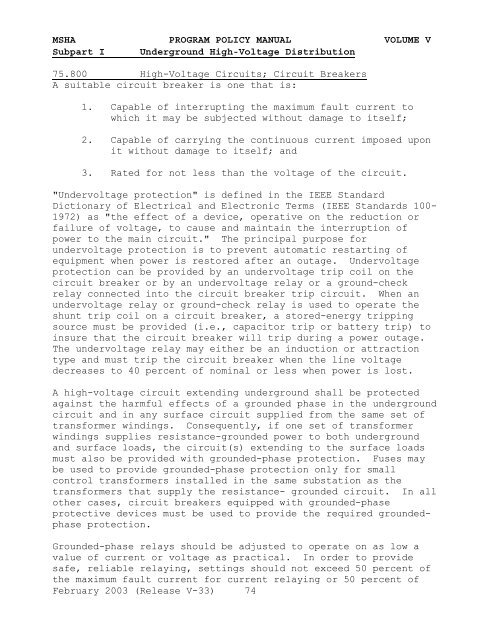Program Policy Manual - VOLUME V - Mine Safety and Health ...
Program Policy Manual - VOLUME V - Mine Safety and Health ...
Program Policy Manual - VOLUME V - Mine Safety and Health ...
Create successful ePaper yourself
Turn your PDF publications into a flip-book with our unique Google optimized e-Paper software.
MSHA PROGRAM POLICY MANUAL <strong>VOLUME</strong> V<br />
Subpart I Underground High-Voltage Distribution<br />
75.800 High-Voltage Circuits; Circuit Breakers<br />
A suitable circuit breaker is one that is:<br />
1. Capable of interrupting the maximum fault current to<br />
which it may be subjected without damage to itself;<br />
2. Capable of carrying the continuous current imposed upon<br />
it without damage to itself; <strong>and</strong><br />
3. Rated for not less than the voltage of the circuit.<br />
"Undervoltage protection" is defined in the IEEE St<strong>and</strong>ard<br />
Dictionary of Electrical <strong>and</strong> Electronic Terms (IEEE St<strong>and</strong>ards 100-<br />
1972) as "the effect of a device, operative on the reduction or<br />
failure of voltage, to cause <strong>and</strong> maintain the interruption of<br />
power to the main circuit." The principal purpose for<br />
undervoltage protection is to prevent automatic restarting of<br />
equipment when power is restored after an outage. Undervoltage<br />
protection can be provided by an undervoltage trip coil on the<br />
circuit breaker or by an undervoltage relay or a ground-check<br />
relay connected into the circuit breaker trip circuit. When an<br />
undervoltage relay or ground-check relay is used to operate the<br />
shunt trip coil on a circuit breaker, a stored-energy tripping<br />
source must be provided (i.e., capacitor trip or battery trip) to<br />
insure that the circuit breaker will trip during a power outage.<br />
The undervoltage relay may either be an induction or attraction<br />
type <strong>and</strong> must trip the circuit breaker when the line voltage<br />
decreases to 40 percent of nominal or less when power is lost.<br />
A high-voltage circuit extending underground shall be protected<br />
against the harmful effects of a grounded phase in the underground<br />
circuit <strong>and</strong> in any surface circuit supplied from the same set of<br />
transformer windings. Consequently, if one set of transformer<br />
windings supplies resistance-grounded power to both underground<br />
<strong>and</strong> surface loads, the circuit(s) extending to the surface loads<br />
must also be provided with grounded-phase protection. Fuses may<br />
be used to provide grounded-phase protection only for small<br />
control transformers installed in the same substation as the<br />
transformers that supply the resistance- grounded circuit. In all<br />
other cases, circuit breakers equipped with grounded-phase<br />
protective devices must be used to provide the required groundedphase<br />
protection.<br />
Grounded-phase relays should be adjusted to operate on as low a<br />
value of current or voltage as practical. In order to provide<br />
safe, reliable relaying, settings should not exceed 50 percent of<br />
the maximum fault current for current relaying or 50 percent of<br />
February 2003 (Release V-33) 74
















